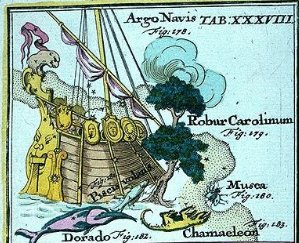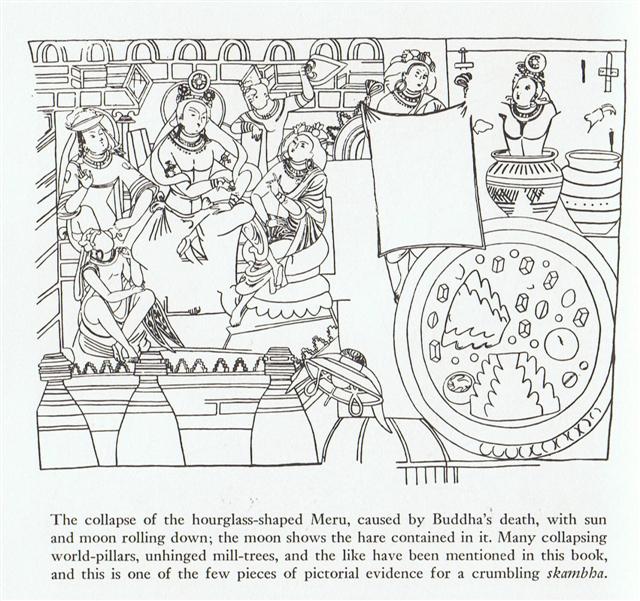443. The June solstice motivated special
treatment.

... The
Mnajdra Temple is located on Malta and very
ancient, dating to the time before the pyramids. Marija
Gimbutas: 'To sleep within the Goddess's womb was to die
and to come to life anew'. In a system of reincarnation
the old one must die in order to be reborn, of course.
At midsummer Sun comes to a standstill, and this must
therefore be an occasion when the 'flame of life' had to
be transported into a new body ...
... Then I
become aware of ... a presence - a faint, ghostly
glimmering, like moonglow, that has appeared on the
solstice stone. I don't know how long it lasts, a second
or two only I would guess, but while it is there it
seems less like a projection - which I know it to be -
than something immanent within the stone itself. And it
seems to function as a herald for it fades almost as
soon as it has appeared and in its place the full effect
snaps on - instantaneously. It wasn't there, and then
it's there. As Chris had described, the effect does
curiously resemble a poleaxe, or a flag on a pole, and
consists of a 'shaft', narrow at the base but widening a
little towards the top, running up the left hand side of
the solstice stone, surmounted by a right-facing 'head'
or 'flag'. An instant later an almond-shaped spot of
light, like an eye, appears a few centimeters to the
right of the 'flag' and the effect is complete. Weirdly
- I do not claim it has any significance - this
flag-on-a-pole symbol is the ancient Egyptian hieroglyph
neter, meaning 'god', or 'a god' - and not to be
understood at all in the Judaeo-Christian usage of that
word but rather as a reference to one of the
supernatural powers or principles that guide and balance
the universe. Manifested here, in this strange Stone Age
temple, it glows, as though lit by inner fire.'
The Egyptian X seems to be treated in the
C text as a reference to the crossing over from winter
to summer. When the Full Moon reached day 120 counted
from Sirrah it could have referred to MARCH 20
(at the time of Spica). From June 21 (solstice) to
heliacal Spica there were 282 - 172 = 110 days, but from
June 21 to Spica at the Full Moon there should be around 110
+ 180 = 290 days. 282 (Spica) + 180 = 462 = 366 + 96. However,
counting in ancient style from true heliacal day 172 + 16 = 188 (July
7) - when the month of the Oak may have ended - we will reach day
366 + 80. And by reducing the day number 160 said to be the
beginning of the Oak month we will find a more
satisfactory 12 * 12 = 144 = 160 - 16.
|
1 |
Horn |
α Virginis (Spica) |
Crocodile |
(202.7) |

|
no glyph |
koia |
ki te hoea |
ki te henua |
te rima te hau tea |
haga i te mea ke |
ki te henua - tagata honui |
111 |
 |
 |
 |
 |
 |
 |
|
Ca1-1 |
Ca1-2 |
Ca1-3 |
Ca1-4 |
Ca1-5 |
Ca1-6 |
|
Sept 20 |
21 (264) |
Equinox |
23 |
24 (☼183) |
25 (*5 + *183) |
26 (☼185) |
|
"Aug 10 (222) |
11 |
12 (265 - 41) |
13 (15 * 15) |
14 |
(227 = 268 - 41) |
16 (*148) |
|
CLOSE TO
THE FULL MOON: |
|
Al Fargh al Thāni-25 (Rear Spout)
0h (365.25)
CAPH (Hand) =
β
Cassiopeiae,
SIRRAH (Navel of the Horse) =
α
Andromedae
(0.5),
ε
Phoenicis,
γ³
Oct.
(0.8) |
Uttara Bhādrapadā-27 (2nd of the Blessed
Feet) /
Wall-14 (Porcupine)
ο Oct. (1.3),
ALGENIB PEGASI = γ Pegasi
(1.8) |
χ Pegasi (2.1), θ Andromedae (2.7) |
σ Andromedae (3.0), ι Ceti (3.3), ζ Tucanae
(3.5), ρ Andromedae, π Tucanae (3.7) |
no star listed (4) |
ANKAA = α Phoenicis,
κ Phoenicis (5.0)
ALPHARD (α Hydrae)
|
λ Phoenicis (6.3), β Tucanae (6.4) |
|
CLOSE TO THE SUN: |
|
ALCHITA = α Corvi,
MA WEI (Tail of the Horse) = δ Centauri
(183.1),
MINKAR = ε Corvi
(183.7), ρ Centauri (183.9) |
PÁLIDA (Pale) =
δ
Crucis
(184.6),
MEGREZ (Root of the Tail) =
δ
Ursae Majoris
(184.9) |
Hasta-13 (Hand) /
Chariot-28 (Worm)
GIENAH (Wing) =
γ
Corvi
(185.1),
ε
Muscae (185.2),
ζ
Crucis (185.4),
ZANIAH (Corner) =
η
Virginis
(185.9)
*144.0 = *185.4 - *41.4 |
CHANG SHA (Long Sand-bank) =
ζ
Corvi
(186.3) |
INTROMETIDA (Inserted) =
ε
Crucis
(187.4),
ACRUX =
α
Crucis
(187.5)
*146.0 = *187.4 - *41.4 |
γ
Com. Berenicis (188.0),
σ
Centauri (188.1),
ALGORAB =
δ
Corvi
(188.5),
GACRUX =
γ
Crucis
(188.7) |
γ
Muscae (189.0),
AVIS SATYRA (Bird of the
Satyrs) =
η
Corvi
(189.3),
ASTERION (Starry) =
β
Canum Ven.
(189.5),
KRAZ = β Corvi,
κ Draconis (189.7) |

... Raven gazed up and down the beach. It
was pretty, but lifeless. There was no one
about to upset, or play tricks upon. Raven
sighed. He crossed his wings behind him and
strutted up and down the sand, his shiny
head cocked, his sharp eyes and ears alert
for any unusual sight or sound. The
mountains and the sea, the sky now ablaze
with the sun by day and the moon and stars
he had placed there, it was all pretty, but
lifeless. Finally Raven cried out to the
empty sky with a loud exasperated cry. And
before the echoes of his cry faded from the
shore, he heard a muffled squeak. He looked
up and down the beach for its source and saw
nothing. He strutted back and and forth,
once, twice, three times and still saw
nothing. Then he spied a flash of white in
the sand. There, half buried in the sand was
a giant clamshell. As his shadow fell upon
it, he heard another muffled squeak. Peering
down into the opening between the halves of
the shell, he saw it was full of tiny
creatures, cowering in fear at his shadow
... |
|
te maitaki |
te henua |
kua haga te
mea ke |
manu puoko i
tona ahi |
kua heu te
huki |
|
Heu.
Offspring of
parents from two different
tribes, person of mixed
descent, e.g. father Miru,
mother Tupahotu.
Heuheu, body hair
(except genitals and armpits).
Vanaga. 1. Heheu; ivi
heheu, the cachalot, bone
needle; hakaheu, spade,
to shovel, to grub up, to
scratch the ground, to labor;
rava hakaheu,
laborious, toilsome. 2.
Hakaheu, affair. Churchill.
M. Heu, to separate, to
pull asunder; the eaves of a
house; heu, a single
hair; hau. to hew;
heru, to comb; huru,
hair on the body; down;
feathers; maheu,
scattered; maheuheu,
shrubs; mahuru, scrub;
heuea, to be separated. Text
Centre.
Nonoma ran, he quickly
went to Te Hikinga Heru
(a ravine in the side of the
crater Rano Kau) and
looked around. There he saw the
double canoe way out near the
(offshore) islets, and the two
(hulls of the canoe) were lashed
together. |
 |
 |
 |
 |
 |
|
Ca5-12 (6 + 112) |
Ca5-13 (472 / 4 = 118) |
Ca5-14 (78 + 41) |
Ca5-15 (120) |
Ca5-16 (11 * 11) |
|
CLOSE TO THE FULL MOON: |
|
July 16 (181 + 16)
AZMIDISKE = ξ Puppis
(117.4)
*76 = *117.4 - *41.4 |
17
φ Gemini (118.4)
*77 = *118.4 - *41.4 |
18
DRUS
(Hard) = χ Carinae
(119.9) |
19 (200 = 79 + 121)
ω Cancri (120.2)
*79 = *120 - *41 |
20
8h (121.7)
χ Gemini (121.0),
NAOS = ζ Puppis
(121.3) |
|
... The Sothic cycle was based
on what is referred to in
technical jargon as 'the
periodic return of the heliacal
rising of Sirius', which is the
first appearance of this star
after a seasonal absence, rising
at dawn just ahead of the sun in
the eastern portion of the sky.
In the case of Sirius the
interval between one such rising
and the next amounts to
exactly 365.25 days - a
mathematically harmonious
figure, uncomplicated by further
decimal points, which is just
twelve minutes longer than the
duration of the solar year
... |
|
MARCH 17 |
18 |
19 (78 = 199 - 121) |
20 |
21 (0h) |
|
... Ecclesiastically, the
equinox is reckoned to be on 21
March (even though the equinox
occurs, astronomically speaking,
on 20 March in most years)
... |
|
CLOSE TO THE SUN: |
|
Jan 16 (197 - 181)
ι Sagittarii (301.2),
TEREBELLUM = ω Sagittarii,
ξ Aquilae (301.3),
ALSHAIN (Falcon) = β Aquilae
(301.6), φ Aquilae (301.8)
*260 = *301 - *41 |
17
ε Pavonis, θ Sagittarii (302.3),
γ Sagittae (302.5), μ Pavonis
(302.7 |
18
τ Aquilae (303.8) |
19
20h (304.4)
η Sagittae (304.2), δ Pavonis
(304.4)
*263.0 = *304.4 - *41.4 |
20
SHANG WEI (Higher Guard) = κ
Cephei
(305.2), θ Sagittae (305.4),
TSEEN FOO (Heavenly Raft) = θ
Aquilae (Ant.)
(305.6),
ξ Capricorni (305.8)
*264.0 = *305.4 - *41.4 |

The Sun was
placed at the Stern → star as in
starboard for the right side of
the ship, the place for women. X
was formed by the timbers which
had held the Sail (Ra) in
its proper place, yet the structure
of which the collision
with the Oak had broken to
pieces. Drus → L. dūrus
= hard (as oak).
... The seventh tree is the oak,
the tree of Zeus, Juppiter,
Hercules, The Dagda (the chief
of the elder Irish gods), Thor,
and all the other Thundergods,
Jehovah in so far as he was
'El', and Allah. The royalty of
the oak-tree needs no enlarging
upon: most people are familiar
with the argument of Sir James
Frazer's Golden Bough, which
concerns the human sacrifice of
the oak-king of Nemi on
Midsummer Day. The fuel of the
midsummer fires is always oak,
the fire of Vesta at Rome was
fed with oak, and the need-fire
is always kindled in an oak-log.
When Gwion writes in the Câd
Goddeu, 'Stout Guardian of the
door, His name in every tongue',
he is saying that doors are
customarily made of oak as the
strongest and toughest wood and
that 'Duir', the Beth-Luis-Nion
name for 'Oak', means 'door' in
many European languages
including Old Goidelic dorus,
Latin foris, Greek thura, and
German tür, all derived from the
Sanskrit Dwr, and that Daleth,
the Hebrew letter D, means
'Door' - the 'l' being
originally an 'r'. Midsummer is
the flowering season of the oak,
which is the tree of endurance
and triumph, and like the ash is
said to 'court the lightning
flash'. Its roots are believed
to extend as deep underground as
its branches rise in the air -
Virgil mentions this - which
makes it emblematic of a god
whose law runs both in Heaven
and in the Underworld ... The
month, which takes its name from
Juppiter the oak-god, begins on
June 10th and ends of July 7th.
Midway comes St. John's Day,
June 24th, the day on which the
oak-king was sacrificially
burned alive. The Celtic year
was divided into two halves with
the second half beginning in
July, apparently after a
seven-day wake, or funeral
feast, in the oak-king's honour
...
... Robur Carolinum,
Charles' Oak, the Quercia
of Italy and the Karlseiche
of Germany, was formally
published by Halley in 1679 in
commemoration of the Royal Oak
of his patron, Charles II, in
which the king had lain hidden
for twenty-four hours after his
defeat by Cromwell in the battle
of Worcester, on the 3rd of
September 1651
...
Raa.
Sun; day; i te raá nei,
today; raá îka, good day
for fishing. Vanaga. 1. Sun. 2.
Day. 3. Time. 4. Name of
sub-tribe. Fischer.
Te manu i te raá
=
comet. Barthel.
'... The substitution of the sun
for the sail, both of which are
called ra or raa
in Polynesia, is a remarkable
feature in Easter Island art ...
' Heyerdahl 3.
1. The sun;
raa ea mai,
raa puneki, sunrise;
raa tini,
raa toa, noon. P
Mgv., Ta.:
ra, the sun. Mq.:
a, id. 2. Day, date;
a raa nei a, to-day,
now;
raa i mua, day
before. P Mgv., Ta.:
ra, a day. Mq.:
a, id. Churchill.
'... The chief thus makes his
appearance at Lakeba from
the sea, as a stranger to the
land. Disembarking at the
capital village of Tubou,
he is led first to the chiefly
house (vale levu) and
next day to the central
ceremonial ground (raaraa)
of the island ...' (Islands of
History)
Ta.: toraaraa,
to raise up. Churchill 2.
LA, s. Haw., sun, light,
day. N. Zeal., ra, sun,
day. Marqu., a, id. Sam.,
la, id. Deriv.: Haw.,
lae, be light, clear,
shining; lai, shining as
the surface of the sea, calm,
still; laelae and
lailai, intens. Sam.,
lelei, something very good;
lala, to shine;
lalangi, to broil. Fiji.,
rai, to see, appear;
rai-rai, a seer, a prophet.
Teor., la, sun. Aru
Islands, lara, id.;
rarie, bright, shining.
Amblaw., laei, sun, day.
Irish, la, lae,
day. Laghmani (Cabul), la'e,
day. Sanskr., laj,
lanj, to appear, shine;
râj, to shine. Ved., to
govern; s. a king. If, as
Benfey intimates, the Sanskrit
verb bhrâj, to shine, to
beam, is 'probably abhi-râj',
an already Vedic contraction,
then the Polynesian root-word
al and lae will
reappear in several of the West
Aryan dialects. Lat.,
flagrare, flamma,
flamen. Greek, φλεγω,
φλοξ.
A.-Sax., blac,
blæcan,
&c.
Probably the universal
Polynesian
lani,
langi,
rangi,
ra'i,
lanits
(Malg.) designating the upper
air, sky, heaven, and an epithet
of chiefs, refers itself to the
same original
la,
lai,
lanj,
referred to above, to which also
be referred: Welsh,
glan,
clean pure, bright, holy. Sax.
clæne,
clean, pure. Swed.,
ren,
clean. pure;
grann
(?), fine, elegant. It may be
noted in connection with this
word, either as a coincidence or
as an instance of ancient
connection, that in the old
Chaldean the name of the sun and
of the Supreme Deity was
Ra,
and that in Egypt the sun was
also named
Ra.
LA²,
s. Haw., Sam., Tong.,
ra.
N. Zeal., the sail of a canoe;
abbreviated from, or itself an
older form of, the Fiji.
laca,
a sail, also the mats from which
the sails were made. Sunda.,
Mal.,
layar,
sail. Malg.,
laï,
sail, tent, flag. Sanskr.,
lâta
(Pictet), a cloth;
latâ
(Benfey), a creeper, a plant;
lak-taka,
a rag. As mats and clothing in
primitive times were made of
bark or flexible plants, the
connection between the Sanskrit
latâ
and Polynesian
laca,
la,
becomes intelligible. Armen.,
lôtig,
a mantle. Lat.,
lodix,
a blanket. Irish,
lothar,
clothing. (Fornander)
 |
|
hakahagana te
honu |
tagata moe
hakarava hia |
ka moe |
hakapekaga mai |
|
Peka.
Pekapeka, starfish.
Vanaga. 1. 100,000 T. 2. A
cross; pekapeka, curly;
pekapekavae, instep T. (?
shoelaces.); hakapeka, to
cross; hakapekapeka, to
interlace, lattice. T Mgv.:
peka, a cross, athwart,
across; pepeka, thick,
only said of a number of shoots
or sprouts in a close bunch.
Mq.: peka, a cross, dense
thicket. Ta.: pea, a
cross. Churchill. Mq.: Pekahi,
to make signs with the hand, to
blow the fire with a fan. Ha.:
peahi, id. Churchill.
 |
 |
 |
 |
 |
|
Ca5-17 |
Ca5-18 |
Ca5-19 |
Ca5-20 (125) |
|
July 21 |
22 |
23 (= 7 + 16) |
24 |
|
... their separation from the
sun is just beyond the minimum
distance 16° that a star may be
from the sun and still be
visible
... |

|

















